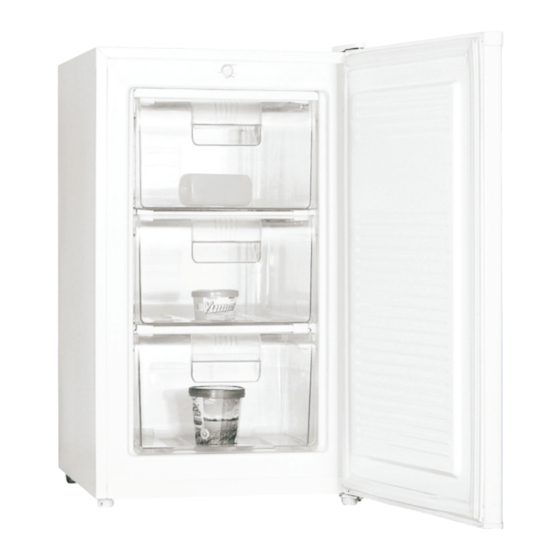
Table of Contents
Advertisement
Advertisement
Table of Contents

Summary of Contents for GVA DD1-10
- Page 1 82L Upright Freezer DD1-10...
- Page 2 General Safety Instructions Read this manual thoroughly before first use, even if you are familiar with this type of product. We have provided many important safety statements in this manual concerning the use of this appliance. Always read and observe all safety statements. They reduce the risk of fire, electric shock and injury when correctly adhered to.
-
Page 3: Electrical Safety
General Safety Instructions (Cont.) Installation • Heavy: This appliance is heavy, take care when moving it. To avoid back or other injury, consider a two person lift or mechanical aid when installing it. • Location: The room for installing appliance must be at least 1M³per 8g of refrigerant. The amount and type of refrigerant in the appliance can be found on the rating plate inside the appliance. -
Page 4: Cleaning And Maintenance
General Safety Instructions (Cont.) Usage conditions and restrictions • Indoor domestic use only: This appliance is intended for indoor household use only. It is not suitable for commercial, industrial or outdoor use. • Intended purpose: Do not use this appliance for anything other than its intended purpose, and only use it as described in this manual. -
Page 5: Table Of Contents
Contents General Safety Instructions Parts List Getting Started Instructions Reversing the Door Swing Care and Maintenance Responsible Disposal Troubleshooting... -
Page 6: Parts List
Parts List NOTE: Due to the production’s improvement, the unit you purchased may vary slightly from below sketch. -
Page 7: Getting Started
Getting Started Before first use • Unpack the appliance but keep all packaging materials until you have made sure your new bar freezer is undamaged and in good working order. • Plastic wrapping can be a suffocation hazard for babies and young children, so ensure all packaging materials are out of their reach. - Page 8 Getting Started (Cont.) • Locate the bar freezer: • Away from direct sunlight, which may affect the acrylic coating. • Away from sources of heat (stove, heater, radiator, dishwasher, etc.),which may increase power consumption. • In an area without extreme cold ambient temperatures, which may affect cooling performance.
-
Page 9: Instructions
Instructions Normal Operating Sounds The following noises are characteristic of refrigeration appliances: Clicks: Whenever the compressor is switched on or off, a click sound may be heard. Humming: As soon as the compressor is in operation, you may hear it humming. Bubbling/Splashing: When refrigerant flows into thin tubes, you may hear bubbling or splashing noises. -
Page 10: Reversing The Door Swing
Reversing the Door Swing This bar freezer can be opened from either the left side (as supplied) or right side to suit your individual installation requirements. If you want to open the door from the right side, follow the instructions below and opposite to reverse the door swing (the numbers in brackets refer to the parts in the illustrations). -
Page 11: Care And Maintenance
Care and Maintenance Defrosting the bar freezer When? For the most efficient operation and minimum energy consumption, defrost the bar freezer when the frost accumulated on the evaporator is about 5mm thick. How? Turn the thermostat dial to the min position and unplug the bar freezer. Remove perishable food items from the freezer and keep them in another freezer or cooler bag to protect the food. -
Page 12: Energy Saving Tips
Care and Maintenance (Cont.) Energy saving tips • Place the freezer in the coolest area of the room, away from heat-producing appliances and out of direct sunlight. • Let hot foods cool down a little before placing them into the freezer. Overloading the freezer forces the compressor to run longer. -
Page 13: Responsible Disposal
Responsible Disposal Responsible disposal • At the end of its working life, do not throw this appliance out with your household rubbish. Electrical and electronic products contain substances that can have a detrimental effect on the environment and human health if disposed of inappropriately. Observe any local regulations regarding the disposal of electrical consumer goods and dispose of it appropriately for recycling and recovery of the refrigerant. -
Page 14: Troubleshooting
Troubleshooting If you experience a problem with your bar freezer, check in the following table for solutions to help you solve the problem. If after these checks you still have a problem with your bar freezer, call the after sales support line for advice. Problem Possible cause The freezer does not operate. - Page 15 Troubleshooting (Cont.) The external freezer surface is • The exterior walls can be warmer than room warm. temperature. This is normal while the compressor works to transfer heat from inside the freezer cabinet. Excessive frost and ice has • The freezer door has been left open. built up.
- Page 16 M.E.W (Australia) Pty Ltd 15 Vaughan St Essendon Fields VIC 3041 ACN 152 719 036 www.gvaproducts.com.au While every effort has been made in the preparation of this instruction manual, the publishers cannot be held responsible for the accuracy of the information contained herein or any consequences arising from it.





Need help?
Do you have a question about the DD1-10 and is the answer not in the manual?
Questions and answers